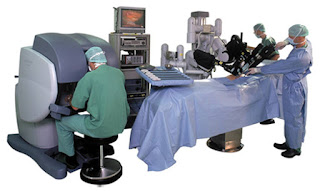 |
| Image Source: da Vinci Robotic Surgery |
Topics: Applied Physics, Biology, Computer Science, Medical Physics, Robotics
The paper describes the usage of robotics for minimally invasive surgery in mostly urology and gynecology; in my case it was sinus surgery. The 144 deaths out of 10,624 (1.4%) robotic surgeries is only small to the statisticians, not the families. I am not against these surgeries (and, if your medical provider is has experience in it, please go with their expertise and judgment), just that we obviously have a few kinks to work out yet. Even though my last thought before surgery was "this looks like Star Trek," I think we're still a few years away from Starfleet Medical.
TECHNOLOGY REVIEW: Robotic surgeons were involved in the deaths of 144 people between 2000 and 2013, according to records kept by the U.S. Food and Drug Administration. And some forms of robotic surgery are much riskier than others: the death rate for head, neck, and cardiothoracic surgery is almost 10 times higher than for other forms of surgery.
Robotic surgery has increased dramatically in recent years. Between 2007 and 2013, patients underwent more than 1.7 million robotic procedures in the U.S., the vast majority of them performed in gynecology and urology. “Yet no comprehensive study of the safety and reliability of surgical robots has been performed,” say Jai Raman at the Rush University Medical Center in Chicago and a few pals.
Physics arXiv:
Adverse Events in Robotic Surgery: A Retrospective Study of 14 Years of FDA Data
Homa Alemzadeh, Ravishankar K. Iyer, Zbigniew Kalbarczyk, Nancy Leveson, Jaishankar Raman
Comments